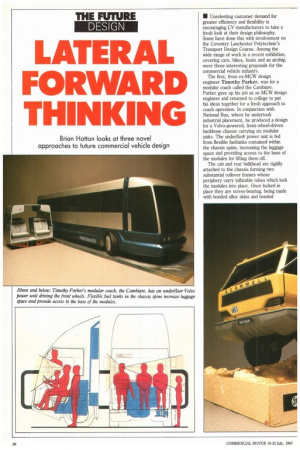LATERAL FORWARD THINKING
Page 40

Page 41

If you've noticed an error in this article please click here to report it so we can fix it.
• Unrelenting customer demand for greater efficiency and flexibility is encouraging CV manufacturers to take a fresh look at their design philosophy. Some have done this with involvement on the Coventry Lanchester Polytechnic's Transport Design Course. Among the wide range of work in a recent exhibition, covering cars, bikes, boats and an airship, were three interesting proposals for the commercial vehicle industry.
The first, from ex-MCW design engineer Timothy Parker, was for a modular coach called the Cambiare. Parker gave up his job as an MCW design engineer and returned to college to put his ideas together for a fresh approach to coach operation. In conjunction with National Bus, where he undertook industrial placement, he produced a design for a Volvo-powered, front-wheel-driven backbone chassis carrying six modular units. The underfloor power unit is fed from flexible fueltanks contained within the chassis spine, increasing the luggage space and providing access to the base of the modules for lifting them off.
The cab and rear bulkhead are rigidly attached to the chassis forming two substantial rollover frames whose periphery carry inflatable tubes which lock the modules into place. Once locked in place they are stress-bearing, being made with bonded alloy skins and bonded glazing, fitting into each other around their periphery with dovetails and plastic seals.
Outriggers beneath the floor fit over PTFE seals on the chassis and are individually spring-bolted into place. Demounting and reassembly are achieved by deflating the locks on the rear bulkhead, unlocking the bolts, slipping the modules apart and removing with a fork lift.
The main aim of the project is to achieve flexibility of operation by allowing modules to be refurbished and updated without taking the chassis out of service. A further development could be the establishment throughout the country of depots holding modules so the role of the vehicle could be changed at termination of its journey. By switching roles, for example, between maximum passenger capacity to airport use with increased baggage capacity, or to a module for the disabled or even one for a mobile executive conference, the management's choice of vehicle becomes almost unlimited.
As a concept for improving structural safety and expanding the use of base units it is to be commended and probably will be investigated further when Timothy Parker starts his new job with National Bus in the North of England.
David Ton's approach to designing an all-terrain truck for the Third World, his Scammell S22, ws to use computer-aided design and drafting. So successful have his methods become that he has been invited to remain with the Polytechnic as an associate lecturer to develop his ideas. The complexity of the investigation into the structure, ergonomics and mechanical geometry are belied by the apparent simplicity of the finished design.
An ergonomically developed plastic cab is mounted well forward on the platform chassis which carries a mid-mounted, underfloor power unit driving all four wheels through driveshafts contained within the long leading and trailing suspension arms. High angularity for increasing ground clearance and a small degree of four-wheel steering is also incorporated into the suspension geometry to increase performance in rough going.
Work experience with ERF has obviously encouraged Craig Yates to look at developing something radical for the domestic truck market. This he has achieved with his proposal for a rigid urban delivery vehicle whose backbone
chassis turns technology upside down by bridging over the top of the load from the back of the cab and branching down to the rear wheels with splayed support units.
The vehicle, powered by a Cummins B Series engine which drives the front wheels through a Leyland CVT transmission, measures only 7-5m overall. Low step height is achieved by forward control, ahead of the transversly mounted power unit, access to which is obtained by sliding it from the rear of the cab after removal of the container.
The boxed steel chassis is plastic clad with SMC panels and connects with the steel frame of the cab unit the skin of which is moulded over the frame in the current ERF manner. All-round air suspension with long trailing arms at the rear enables containers to be collected by reversing over them with fully lowered suspension, the container then being pneumatically locked in, raising the ride height and driving off.
It is thought that the advantage of the demountable container could also be extended by this form of vehicle, which supports the load from above, to cover the transport of bulk liquids in specially constructed underslung tanks. Perhaps we will hear more of this project when Craig Yates returns to full-time work as a designer with ERF.
0 Brian Hatton












































































